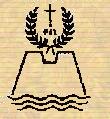|
LIFE IN THE
DESERT III
The Christians went to the
desert to see the greatest athletic event, the spiritual combat between good
and evil. And they took mental snapshots for their long meditations
back home. These were some of the things they saw.
The monks lived in cells
ordinarily made up of two rooms: one for sleeping, the other for other
purposes like receiving guests. The monk Ammonius had a beautiful
courtyard and a well; it was very private though. More common were
monasteries where many monks lived together in dorms and/or single rooms
with a common refectory, kitchen and church. Most monasteries
emphasized the importance of being self-sufficient so that the monks
remained inside and "none ever went out." So the walls of
the monastery were not meant to protect the monks from outside attacks; it
was primarily meant to emphasize the desire of the monks to remain
undisturbed within the walls of the monastery. St. Isidore prohibited
guests from talking freely with the monks.
A slight variation is the
monastery of Oxyrhynchus which was a town-monastery inhabited exclusively by
monks and nuns who had their own bishop.
Life in the desert was reduced
to essentials; this is fundamental to monasticism, i.e. food, sleep and
clothing. Some stayed awake the whole night chanting psalms. . .in
early times, these Christians were called "the sleepless
ones". Usually one hour of sleep was enough. Ideally, most
ate once a day. . .and only a little, at the 9th hour. Their food was
dry bread and green herbs. The bread could be kept indefinitely and
was soaked in water to make them edible.
In Pachomius' monastery, they
had fresh bread, soup and olives. The monks usually ate the gifts
given them, like beans and lentils. Their luxury? Fresh fruits
and a pitcher of fresh milk.
The desert-dwellers
disciplined themselves over sleep, food and clothing. Their clothing,
above all showed that they were monks. Paul wore a tunic made of palm
leaves; Macarius dressed in rags; Helle, in patches. In monasteries,
however, a formal uniform was adopted; usually a tunic and a cowl. In
church, the monks dressed in white. Paternuthius described a
short-sleeved tunic, a hood, a cloak for the cold, a chord around the
waist.
The manual work of monks was
agriculture for their self-subsistence. They grew herbs and vegetables
and corn for bread. There was no mention of studies, readings or
copying of books. And yet the hermits were known to be most learned in
all fields, especially in Scriptures, even if, like Paternuthius, they were
"illiterate". Truly, wisdom is God's promised wisdom;
". . .I shall teach you all things. . ."
The monks chanted the psalms
continually; at least the 150 psalms in one day. The recitation of the
psalms during fixed times like Prime, Terce, Sext, None, Vespers and
Compline, Matins and Lauds was considered a dangerous innovation introduced
by "lazy" monks.
The Holy Sacrifice of the Mass
was a luxury. It was celebrated in many monasteries once a year.
The luckier monasteries had mass only on Sundays. The only unique
monastery was that of Apollo which had daily mass. It was celebrated
usually at 12:00 noon or 2:00 p.m. and the monks received communion in their
hands.
Historia Monachorum
(05-09-05)
|

